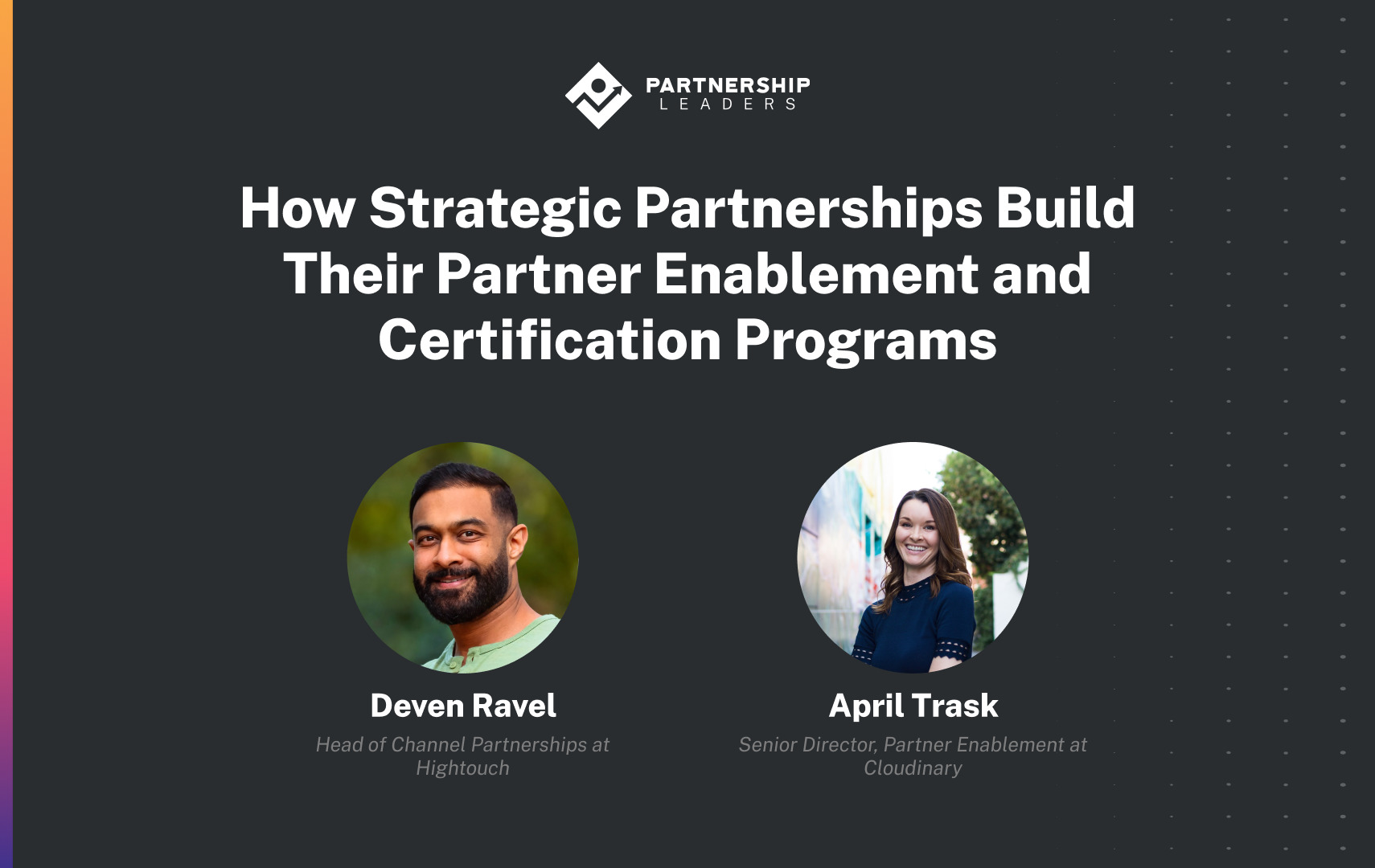The complexity of partner diversity, combined with the changing technological landscape, makes partner enablement and certification more crucial than ever. But how do strategic partnerships deal with these challenges to create a robust and effective partner program?
Deven Revel, Head of Channel Partnerships at Hightouch, and April Trask, Senior Director for Partner Enablement at Cloudinary, delved deep into this topic in our Partnership Leaders webinar.

As we unpack their insights, you’ll discover actionable strategies to elevate your partner programs and business success.
The Challenge of Partner Diversity
Understanding and addressing partners’ diverse needs and motivations is no small feat. In business partnerships, one size certainly does not fit all. Each partner brings a unique set of expectations, goals, and challenges. While being a strength, this diversity can also pose challenges for strategic partnerships.
Here are some common missteps businesses might encounter:
- Over-reliance on Technology: Trask says, “Don’t use technology as your solution. Find your solution first and use technology.” It’s essential to understand that technology should be a tool to enhance the solution, not the solution itself.
- Not Tailoring Technology to Partner Needs: With the vast array of technological tools available, adopting the latest and greatest is tempting without considering if it truly aligns with the partners’ needs. This can lead to wasted resources and missed opportunities.
- Ignoring the Human Element: Technology can streamline processes and offer data-driven insights but cannot replace the human touch. Building relationships, understanding motivations, and fostering trust are aspects that technology alone cannot achieve.
- Lack of Integration: As strategic partnerships adopt various technological tools, integration becomes crucial. A disjointed tech stack can lead to inefficiencies, miscommunication, and missed opportunities. As Trask emphasized, a certification program, for instance, needs a platform that can integrate seamlessly with a testing platform and a proctoring platform.
In the next section, let’s look at how we can overcome these challenges.
Three Tips to Build an Effective Partner Enablement Program
Crafting a partner enablement program that resonates with diverse partners and drives tangible results is both an art and a science. It requires a deep understanding of partner needs, a strategic approach, and the right tools and processes. Let’s delve deeper into the components of a successful enablement program.
1. Customize Components for Specific Partner Experiences
Every partner is unique, with distinct motivations, goals, and challenges. While a foundational enablement program can cater to the majority, the customized components truly make a difference.
- Tailored Training: Not all partners require the same training. Businesses can ensure that partners have the knowledge they need by offering tailored training modules based on the partner’s expertise level, industry, or target audience.
- Segmented Communication: Partners differ in how they prefer to receive information. Some may prefer webinars, while others benefit from one-on-one sessions. Segmenting communication ensures that partners receive information in a format that resonates with them.
- Feedback Loops: Establishing regular feedback loops allows strategic partnerships to understand what’s working and what’s not. This continuous feedback helps in refining the enablement program and making necessary adjustments.
Trask’s insight underscores this approach:
“For building a program, how do you build a foundation that’s actually going to serve not just the loud partners but are going to serve the broadest number of partners?”
2. Add an Integrated Certification Program
Certification goes beyond just training – it’s a validation of a partner’s skills and expertise. An integrated certification program ensures that partners meet a certain standard, reinforcing trust and credibility.
- Valid, Reliable, and Fair: As Trask highlighted, “A certification is what’s called a high stakes experience… a test that is valid, reliable, and fair.” It’s crucial that the certification process is transparent and holds partners to a consistent standard.
- Integration with Other Platforms: A robust certification program requires integration with testing and proctoring platforms. This ensures that the certification process is seamless and efficient.
- Continuous Learning: Certification shouldn’t be a one-time event. Constant learning opportunities ensure partners stay updated with the latest trends and best practices.
3. Comprehensive Onboarding and Experiences
The initial stages of a partnership are critical. A comprehensive onboarding process sets the tone for the partnership journey, ensuring that partners feel valued, informed, and equipped to succeed.
- Structured Onboarding: A step-by-step onboarding process ensures that partners understand the business’s values, products, and expectations immediately.
- Blended Learning: Combining different learning methods, from e-learning modules to hands-on workshops, ensures that partners receive a holistic learning experience.
- Engagement Opportunities: Regular engagement opportunities, from webinars to networking events, ensure that partners stay connected and informed.
“A mature program is going to have really interesting onboarding. It’s probably going to have low stakes, small experiences,” Trask said
Conclusion
Great partner onboarding programs are essential for long-term success. Companies can ensure that partners understand the business’s values and offerings by focusing on brand voice, structured onboarding, blended learning, and engagement opportunities. This helps foster strong relationships between partners and businesses and increases their satisfaction in the long run.
Join The 1700+ Leaders Transforming Partnerships
As a member of Partnership Leaders you will:
- Build and learn with the top partner people at the best companies around the world.
- Increase your impact and accelerate your career with proven resources, tools, and best practices.
- Grow a network of peers, partners, and advisors with common objectives.


